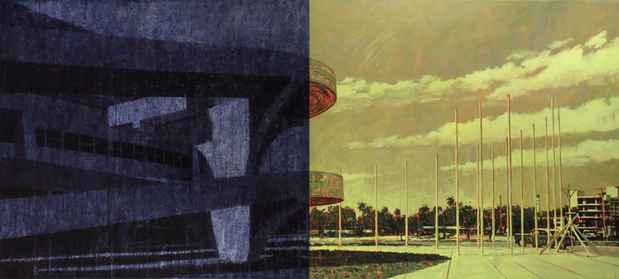Gustavo Acosta “Inventory Of Omissions”
532 Gallery Thomas Jaeckel

This event has ended.
The paintings in Gustavo Acosta’s “Inventory of Omissions” may initially seem like discrete chapters in a visual essay on the oppressive bleakness of the modern city, but such a reading misses the point of his static but intensely hued portrayals of sites in Havana, Miami, New York, and Aleppo. A closer and more thoughtful observation of these canvases reveals the artist’s focus on drawing our attention to the small flashes of vitality and inspiration lurking within each setting’s apparent drabness, and quietly warning us about the things that threaten to obscure our awareness of the vibrant world that’s immediately around us. Throughout these works, there is a concern with engaging with the neglected and the antiquated in the hope of revealing its meaning and its living purpose for the present.
Acosta’s rectilinear overlays of strong, intensely moody colors are the defining element of a unique visual language that integrates multiple subtle allusions to reason and its traditions — the ideal planned-city street grid; the Golden Ratio and its long history as a supposedly true and self-evident compositional principle; the sharp-edged, no-nonsense Bauhaus aesthetic — each of which in turn so patly symbolizes humanity’s forceful and conceited imposition of a supposedly more perfect and efficient order upon nature’s seeming unruliness.
However, each filter-like patch of color also hints that there are life-affirming revelations awaiting discovery in the seemingly exhausted old world immediately around us. The dawn-to-midnight juxtaposition of yellow, maroon, and dark violet in Catalog of Missing Parts II (2017) suggests a single scene viewed at different times through disparate eyes; the painting’s sunny accentuation of a few lively windblown palm trees clustered alongside a massive, inert concrete complex speaks of life’s joyous persistence in the face of entropy, cultural stagnation, and humanity’s fussy and stubborn desire to forever halt time by means of structures and systems. Acosta has said that his use of color in these works is partly rooted in an old memory of people in his native Cuba crafting their own versions of color television by tinting their black-and-white screens with abstract patterns of bright pigments. The story is a perfect symbol of Acosta’s faith in people’s ability to create their way out of the stultifying constrictions of a programmed rational system, if only they can learn to look closely at the world around themselves in search of its small wonders.
Yet Acosta’s paintings also remind us of how easily memory and perception can become fuzzy, especially when technology and mediation intervene to obscure our most vivid and immediate experiences of the world around us. In The Temptation to Look Back (2017), the serene, dark-blue image of a ship’s wake is violently bisected by a thin, garish yellow band that distorts the sea’s graceful undulations into a garish pixelated parody (once again, a technological grid intrudes and has its way with the natural world). A view of Niagara Falls is given a similar treatment in The Great Systems (2017), with an added wrinkle: the scene is derived from an 1857 painting by Frederic Edwin Church, making Acosta’s canvas an image of an image, a scene twice removed from nature and twice distorted by an additional level of nostalgic artistic and historical mediation. In these images, Acosta hints that we must never take nature or our connection with it for granted; there’s always another intrusive and artificial system of control lurking on the margins, waiting to deaden our perceptions. As in his cityscapes, the question as to whether our use of the world will help us perceive its concealed spark of divine life or lead us to snuff it out through domination and neglect is left up for grabs, and it’s up to us to never let our perpetually endangered sense of wonder become permanently entombed beneath the rubble of our collective past.
Media
Schedule
from September 07, 2017 to October 14, 2017
Opening Reception on 2017-09-07 from 18:00 to 20:00